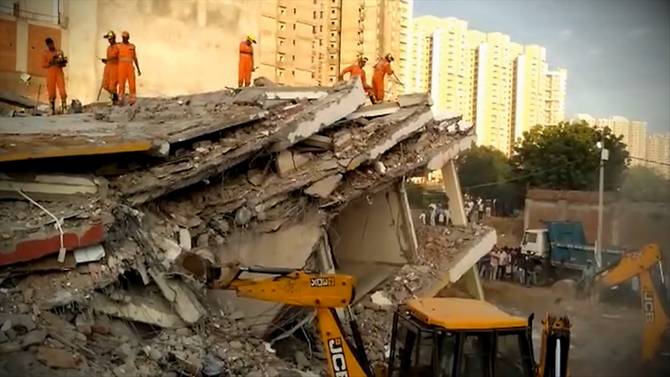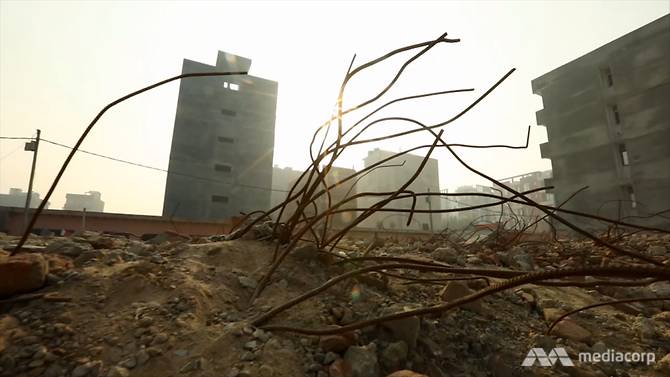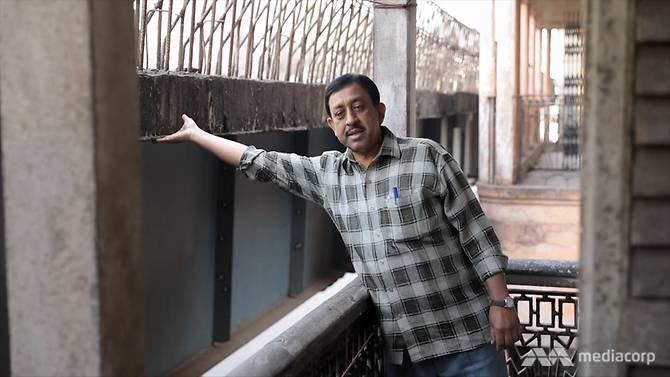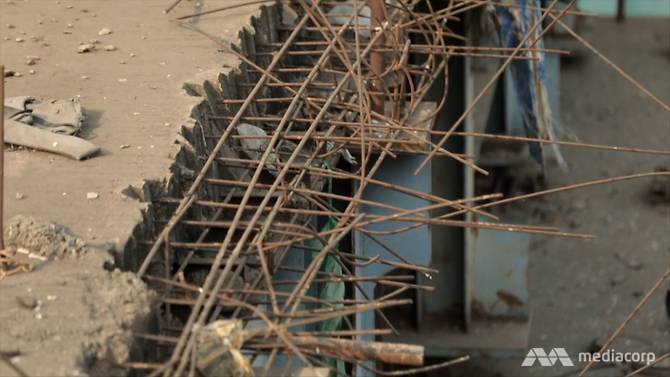https://www.channelnewsasia.com/new...-flyover-collapse-construction-mafia-11629348
CNA Insider India's daily slate of building collapses - and the mafia's role in it
Some seven incidents of structural collapse take place each day in India, killing thousands every year. Get Real investigates the woes of shoddy materials and planning plaguing its booming construction industry.
On average, there were seven incidents of structure collapse a day between 2001 and 2015.
By Desmond Ng
15 Jun 2019 06:15AM
Share this content

Bookmark
INDIA: It was just past noon in one of Kolkata’s busiest neighbourhoods and a big new flyover was under construction.
Malati Devi knew that flyover well – her husband ran a humble incense shop directly under it.
That day, she left the shop to distribute her son’s wedding cards; her husband decided not to accompany her.
Minutes later, parts of the Vivekananda Road flyover came crashing down, burying Devi’s husband in the rubble.
“We started searching everywhere for him, then we spotted something in the rubble. My son saw his little finger sticking out and recognised it as his father’s,” recalled Devi.
That 2016 construction accident injured 80 and killed 26 people. And it is just one of a slew of construction failures across India in which 38,000 people have died since 2001.
Digging into the country’s thriving construction industry, Get Real discovered a web of coercion, collusion and corruption where the dangerous construction mafia often call the shots. (Watch the episode here.)
‘ACT OF GOD’ OR?
It has been estimated that India’s construction industry is worth over US$500 billion (S$682b). But as it expands, corners are being cut, often with deadly consequences.
On average, there were seven incidents of structure collapse a day between 2001 and 2015.
WATCH: Why buildings and flyovers are falling down (4:37)
In the Vivekananda project, infrastructure firm IVRCL was awarded the contract in 2009 despite having been blacklisted and facing a probe by the Central Bureau of Investigation.
The project was to be completed by 2011, but construction was halted several times because of financial issues. By 2015, the company had already missed nine deadlines and was under pressure to finish work.
When the section collapsed in 2016, the firm termed it an “Act of God”.
Lawyer Chandrashekhar Jha was hired by some of the residents to sue the state government and IVRCL – they feared that the remaining structure was a threat to public safety and wanted it demolished.
“IVRCL had bid for the project but the bid was not floated properly. No public tender or quotation had been issued,” said Jha. “A public notification was never issued.”
This is how close the flyover has been built to this resident's home.
Jha also discovered that IVRCL had a terrible track record in many other states – in Jharkand, it was blacklisted by the state government for haphazard work while in Uttar Pradesh, the firm was accused of using sub-standard construction materials for sewage projects.
And yet the authorities decided to let the firm be the contractor for the Vivekananda project.
SHODDY MATERIALS
After the incident, the authorities started to question the work of IVRCL, setting up a panel of technical experts to investigate the incident.
The findings pinpointed alleged faulty design, poor workmanship and a lack of supervision as the main causes of the collapse. But the full report was never released, and neither was anyone held accountable.
Frustrated, journalist Sohini Chattopadhyay began her own investigation. Approaching the police, the state government and IVRCL for answers, she was stonewalled by all.
She later discovered that IVRCL had entered a joint venture with a mysterious Chinese company so as to boost its own credentials and to win the huge project. The contract stipulated that the Chinese company take the lead in the project and provide construction experts on site, but these obligations were never honoured.
“They were never involved in any of the actual ground meetings (or those) that were held with the government,” she said.
A charge sheet which she obtained also mentioned quality issues with the steel used in the collapsed section.
Amitabha Ghoshal, the president of the Consulting Engineers Association of India, also found some quality issues with the construction, particularly the welding; the fabrication; and even the number of bolts used was inadequate.
The Vivekananda project, on which work has been halted.
As Get Real was in the midst of investigating this collapse, a concrete chunk fell off another flyover in Gurugram, about an hour’s drive from New Delhi.
Gurugram resident Vijay Yadav pointed out that “extremely poor quality concrete was used” and that just a year ago, “a portion of the same flyover fell and it was repaired”.
The frequency of these structural collapses prompted Pratap Padode, founder of First Construction Council – a think tank that promotes best practices in India’s construction industry – to look into the root causes of these incidents, such as the steel used in the industry.
He found that 70 per cent of the steel brands he sampled contained high levels of impurities. The discovery is significant: If a steel rod contains a high level of these impurities, it will corrode rapidly, weakening the structure.
Padode said it simply costs steelmakers more to produce good quality steel.
THE MAFIA RUN THE SHOW
To make matters worse, there are mafia syndicates bullying builders into buying their subpar construction materials at inflated prices.
Journalist Snehal Sengupta, who has been investigating these syndicates that deal with construction materials, said that “what they supply is actually not up to the mark of what these infrastructure projects require”.
Some of these syndicates turned into armed cartels that control almost the supply of construction material, and people are scared of them, said Sengupta.
Avishek Paul, owner of Punam Construction Group, had been buying materials from a syndicate but he found the quality wanting and decided to look for alternate suppliers. The syndicate then turned violent, Paul said:
“They hit us with rods and bamboo sticks. We complained to the police, we went to the local Member of the Legislative Assembly,” he said. “He refused to take action and told us to take care of the matter ourselves.”
One syndicate boss ‘Bhai’ told Get Real that it’s subjective whether the quality of the materials he supplies are up to standard.
“If I’m working with ten people, it could be that eight don’t like what I give them,” he said. “If I have to worry about who likes me or who doesn’t, I won’t be able to do business.”
He also lets on that syndicates have to make donations to political clubs and aside from supplying materials, they also provide financial support to developers.
“Everyone thinks that the syndicate beats up people, brandishes guns, stops projects. Nowadays the syndicate funds projects,” said Bhai.
With the financial muscle to fund building projects themselves and to bribe officials, syndicates have fuelled several illegal housing projects across India, most of them built without proper oversight.
DISASTER AWAITS
Another problem is that getting approvals from the authorities can often be a long-drawn-out, tedious process.
So, builders who want to hasten construction simply don’t bother getting approvals.
Local municipal bodies are tasked with approving building plans and checking for compliance with regulations and building bylaws.
But the governing bodies usually just give the go-ahead based on the paperwork provided by the builder, said Mittal, who is also on the National Building Code committee.
“For any building to be approved, there must be a certificate from an engineer with the authorities which shows that the building will be designed as per the code,” he said.
“There should be someone who can do these kind of checks, whether the designs submitted by engineers or architects are in order or not.”
Ghoshal thinks these are just signs of a much bigger issue plaguing India’s construction industry – the lack of regulatory supervision.
Added Manoj Mittal, the former president of the Indian Association of Structural Engineers: “If you do high-rise construction without proper design and without adequate supervision, then disaster awaits.”
In Kolkata, three years after the flyover collapsed, construction has come to a standstill, with the families of the victims still seeking justice.
Resident Rajendra Kumar called for the court to be more prompt in punishing those responsible.
“The construction company feels they can get away with building unsafe structures because the legal system is so slow,” he said.
And if the Indian government fails to enforce effective regulations and laws for the nation’s construction industry, innocent people will continue to die in the rubble of negligence.
“This has gone the way of many public infrastructure accidents in India, which is that things happen and people are very sad,” said Chattopadhyay. “Some compensation is given out, newspapers are shocked for a week, two weeks but everybody forgets about it.”
Watch this episode of Get Real here.
Source: CNA/yv
Share this content
CNA Insider India's daily slate of building collapses - and the mafia's role in it
Some seven incidents of structural collapse take place each day in India, killing thousands every year. Get Real investigates the woes of shoddy materials and planning plaguing its booming construction industry.
On average, there were seven incidents of structure collapse a day between 2001 and 2015.
By Desmond Ng
15 Jun 2019 06:15AM
Share this content

Bookmark
INDIA: It was just past noon in one of Kolkata’s busiest neighbourhoods and a big new flyover was under construction.
Malati Devi knew that flyover well – her husband ran a humble incense shop directly under it.
That day, she left the shop to distribute her son’s wedding cards; her husband decided not to accompany her.
Minutes later, parts of the Vivekananda Road flyover came crashing down, burying Devi’s husband in the rubble.
“We started searching everywhere for him, then we spotted something in the rubble. My son saw his little finger sticking out and recognised it as his father’s,” recalled Devi.
When we pulled him out, my son called to him ‘Papa, Papa’. He responded a bit, then breathed his last.
That 2016 construction accident injured 80 and killed 26 people. And it is just one of a slew of construction failures across India in which 38,000 people have died since 2001.
Digging into the country’s thriving construction industry, Get Real discovered a web of coercion, collusion and corruption where the dangerous construction mafia often call the shots. (Watch the episode here.)
‘ACT OF GOD’ OR?
It has been estimated that India’s construction industry is worth over US$500 billion (S$682b). But as it expands, corners are being cut, often with deadly consequences.
On average, there were seven incidents of structure collapse a day between 2001 and 2015.
WATCH: Why buildings and flyovers are falling down (4:37)
In the Vivekananda project, infrastructure firm IVRCL was awarded the contract in 2009 despite having been blacklisted and facing a probe by the Central Bureau of Investigation.
The project was to be completed by 2011, but construction was halted several times because of financial issues. By 2015, the company had already missed nine deadlines and was under pressure to finish work.
When the section collapsed in 2016, the firm termed it an “Act of God”.
Lawyer Chandrashekhar Jha was hired by some of the residents to sue the state government and IVRCL – they feared that the remaining structure was a threat to public safety and wanted it demolished.
“IVRCL had bid for the project but the bid was not floated properly. No public tender or quotation had been issued,” said Jha. “A public notification was never issued.”
This is how close the flyover has been built to this resident's home.
Jha also discovered that IVRCL had a terrible track record in many other states – in Jharkand, it was blacklisted by the state government for haphazard work while in Uttar Pradesh, the firm was accused of using sub-standard construction materials for sewage projects.
And yet the authorities decided to let the firm be the contractor for the Vivekananda project.
SHODDY MATERIALS
After the incident, the authorities started to question the work of IVRCL, setting up a panel of technical experts to investigate the incident.
The findings pinpointed alleged faulty design, poor workmanship and a lack of supervision as the main causes of the collapse. But the full report was never released, and neither was anyone held accountable.
Frustrated, journalist Sohini Chattopadhyay began her own investigation. Approaching the police, the state government and IVRCL for answers, she was stonewalled by all.
She later discovered that IVRCL had entered a joint venture with a mysterious Chinese company so as to boost its own credentials and to win the huge project. The contract stipulated that the Chinese company take the lead in the project and provide construction experts on site, but these obligations were never honoured.
“They were never involved in any of the actual ground meetings (or those) that were held with the government,” she said.
A charge sheet which she obtained also mentioned quality issues with the steel used in the collapsed section.
It was made with steel samples which had been rejected.
"This is quite shocking… every sample is checked by an independent authority,” she noted. “And if the independent authority had rejected it, why were these used?”Amitabha Ghoshal, the president of the Consulting Engineers Association of India, also found some quality issues with the construction, particularly the welding; the fabrication; and even the number of bolts used was inadequate.
The Vivekananda project, on which work has been halted.
As Get Real was in the midst of investigating this collapse, a concrete chunk fell off another flyover in Gurugram, about an hour’s drive from New Delhi.
Gurugram resident Vijay Yadav pointed out that “extremely poor quality concrete was used” and that just a year ago, “a portion of the same flyover fell and it was repaired”.
The frequency of these structural collapses prompted Pratap Padode, founder of First Construction Council – a think tank that promotes best practices in India’s construction industry – to look into the root causes of these incidents, such as the steel used in the industry.
He found that 70 per cent of the steel brands he sampled contained high levels of impurities. The discovery is significant: If a steel rod contains a high level of these impurities, it will corrode rapidly, weakening the structure.
Padode said it simply costs steelmakers more to produce good quality steel.
THE MAFIA RUN THE SHOW
To make matters worse, there are mafia syndicates bullying builders into buying their subpar construction materials at inflated prices.
Journalist Snehal Sengupta, who has been investigating these syndicates that deal with construction materials, said that “what they supply is actually not up to the mark of what these infrastructure projects require”.
Some of these syndicates turned into armed cartels that control almost the supply of construction material, and people are scared of them, said Sengupta.
Avishek Paul, owner of Punam Construction Group, had been buying materials from a syndicate but he found the quality wanting and decided to look for alternate suppliers. The syndicate then turned violent, Paul said:
Fifteen to 20 boys turned up and tried to shut down the work site. They threatened and beat up the labourers on site.
To fight back, he set up the New Town Developers Association and convinced 160 other companies to join. That triggered more attacks.“They hit us with rods and bamboo sticks. We complained to the police, we went to the local Member of the Legislative Assembly,” he said. “He refused to take action and told us to take care of the matter ourselves.”
One syndicate boss ‘Bhai’ told Get Real that it’s subjective whether the quality of the materials he supplies are up to standard.
“If I’m working with ten people, it could be that eight don’t like what I give them,” he said. “If I have to worry about who likes me or who doesn’t, I won’t be able to do business.”
He also lets on that syndicates have to make donations to political clubs and aside from supplying materials, they also provide financial support to developers.
“Everyone thinks that the syndicate beats up people, brandishes guns, stops projects. Nowadays the syndicate funds projects,” said Bhai.
With the financial muscle to fund building projects themselves and to bribe officials, syndicates have fuelled several illegal housing projects across India, most of them built without proper oversight.
DISASTER AWAITS
Another problem is that getting approvals from the authorities can often be a long-drawn-out, tedious process.
So, builders who want to hasten construction simply don’t bother getting approvals.
Local municipal bodies are tasked with approving building plans and checking for compliance with regulations and building bylaws.
But the governing bodies usually just give the go-ahead based on the paperwork provided by the builder, said Mittal, who is also on the National Building Code committee.
“For any building to be approved, there must be a certificate from an engineer with the authorities which shows that the building will be designed as per the code,” he said.
“There should be someone who can do these kind of checks, whether the designs submitted by engineers or architects are in order or not.”
Ghoshal thinks these are just signs of a much bigger issue plaguing India’s construction industry – the lack of regulatory supervision.
Added Manoj Mittal, the former president of the Indian Association of Structural Engineers: “If you do high-rise construction without proper design and without adequate supervision, then disaster awaits.”
In Kolkata, three years after the flyover collapsed, construction has come to a standstill, with the families of the victims still seeking justice.
Resident Rajendra Kumar called for the court to be more prompt in punishing those responsible.
“The construction company feels they can get away with building unsafe structures because the legal system is so slow,” he said.
And if the Indian government fails to enforce effective regulations and laws for the nation’s construction industry, innocent people will continue to die in the rubble of negligence.
“This has gone the way of many public infrastructure accidents in India, which is that things happen and people are very sad,” said Chattopadhyay. “Some compensation is given out, newspapers are shocked for a week, two weeks but everybody forgets about it.”
Watch this episode of Get Real here.
Source: CNA/yv
Share this content





